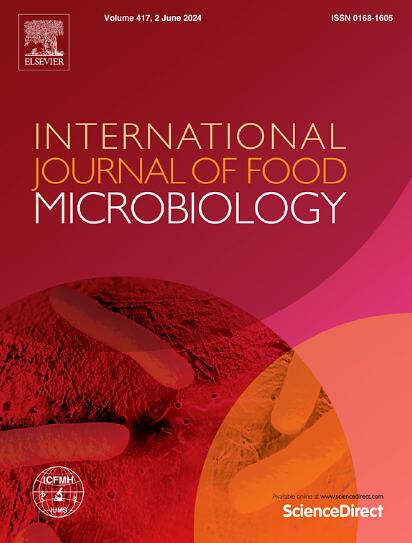牛肉汁中单核增生李斯特菌生物膜形成过程、微观结构及功能基因表达的研究
IF 5
1区 农林科学
Q1 FOOD SCIENCE & TECHNOLOGY
International journal of food microbiology
Pub Date : 2025-03-17
DOI:10.1016/j.ijfoodmicro.2025.111160
引用次数: 0
摘要
单核细胞增生李斯特菌生物膜被认为是食品工业中常见的交叉污染源,生牛肉和牛肉产品是常见的食品库。单增李斯特菌序列9型(ST9)和ST8型是肉类和肉类加工环境中常见的分离菌株。在这项研究中,选择牛肉汁并将其与实验室培养基(含0.6%酵母提取物的色氨酸大豆肉汤,TSB-YE)进行比较。本研究旨在研究牛肉汁对ST9和ST8菌株生物膜形成的影响,包括生物膜微观结构和生物膜形成过程的建模。然后研究了生物膜功能基因在两种培养基中的表达情况。单核增生乳杆菌ST9和ST8在牛肉汁中孵育48 h后可形成多层细胞的致密三维结构生物膜,但两株菌株在TSB-YE中均形成单层生物膜结构。在相同的培养条件下,ST9菌株比ST8菌株在不锈钢表面上产生更多的无根细胞。Logistic模型较好地拟合了生物膜的形成过程,并且在牛肉汁和TSB-YE中估计的模型参数存在较大差异。在相同条件下,牛肉汁的最大特定生物膜形成率(μmax)高于TSB-YE。这表明牛肉汁可以促进单核增生乳杆菌的生物膜形成,表明牛肉汁中的颗粒起到表面调节剂的作用,支持附着。然而,牛肉汁中不锈钢膜上形成的单核增生乳杆菌生物膜的最大数量(Ymax)小于TSB-YE。ST9菌株比ST8菌株表现出更强的生物膜形成能力,这与扫描电镜图像一致。在相应的培养悬浮液中,贴壁细胞数量随着浮游细胞数量的增加而增加。此外,两种培养基中生物膜功能基因的表达也有显著差异。与在TSB-YE中培养的生物膜相比,ST9和ST8菌株牛肉汁中生物膜agrA基因的表达均显著下调,而ST8菌株的inlB和actA基因的表达均显著上调。结果表明,牛肉汁可促进肉类加工过程中单核增生乳杆菌的生物膜形成,为控制生物膜的形成提供了新的思路。本文章由计算机程序翻译,如有差异,请以英文原文为准。
Elucidating the biofilm formation process, microstructure and functional gene expression of Listeria monocytogenes in beef juice
Listeria monocytogenes biofilm is recognized as a frequent cross-contamination source in the food industry, with raw beef and beef products as common food reservoirs. L. monocytogenes sequence types 9 (ST9) and ST8 are frequently isolated in meats and meat processing environment. In this study, beef juice was selected and compared to a laboratory medium (tryptone soy broth with 0.6 % yeast extract, TSB-YE). The purpose of this work was to investigate the effect of beef juice on the biofilm formation of ST9 and ST8 strains, including biofilm microstructure and modelling the biofilm formation process. Then the expression of biofilm functional genes in two culture media was also investigated. L. monocytogenes ST9 and ST8 can form a dense three-dimensional structure biofilm with multilayers of cells in beef juice after 48 h of incubation, but both strains formed a monolayer biofilm structure in TSB-YE. The ST9 strain developed more sessile cells on the stainless-steel surfaces than the ST8 strain under the same culture conditions. The Logistic model showed a good fit for with the biofilm formation process, and the estimated model parameters in beef juice and TSB-YE were considerably different. Under the same conditions, the maximum specific biofilm formation rate (μmax) in beef juice was higher than that in TSB-YE. This indicated that beef juice can facilitate the biofilm formation of L. monocytogenes, suggesting that the particles in beef juice act as a surface conditioner to support attachment. However, the maximum counts of L. monocytogenes biofilm formed on stainless steel coupon (Ymax) in beef juice was smaller than that in TSB-YE. The ST9 strain exhibited a stronger biofilm formation ability than the ST8 strain, and this was consistent with the scanning electron microscopy images. In the corresponding culture suspensions, the number of adherent cells increases with the number of planktonic cells. Moreover, the expression of biofilm functional genes was significantly different in the two culture media. Compared to biofilm cultured in TSB-YE, the expression of the agrA gene of biofilm in beef juice was significantly down-regulated for both the ST9 and the ST8 strains, and the expression of the inlB and the actA genes were dramatically up-regulated for the ST8 strain. Our results suggested that beef juice promotes biofilm formation of L. monocytogenes in meat processing and provide new insights into controlling biofilm.
求助全文
通过发布文献求助,成功后即可免费获取论文全文。
去求助
来源期刊
CiteScore
10.40
自引率
5.60%
发文量
322
审稿时长
65 days
期刊介绍:
The International Journal of Food Microbiology publishes papers dealing with all aspects of food microbiology. Articles must present information that is novel, has high impact and interest, and is of high scientific quality. They should provide scientific or technological advancement in the specific field of interest of the journal and enhance its strong international reputation. Preliminary or confirmatory results as well as contributions not strictly related to food microbiology will not be considered for publication.

 求助内容:
求助内容: 应助结果提醒方式:
应助结果提醒方式:


